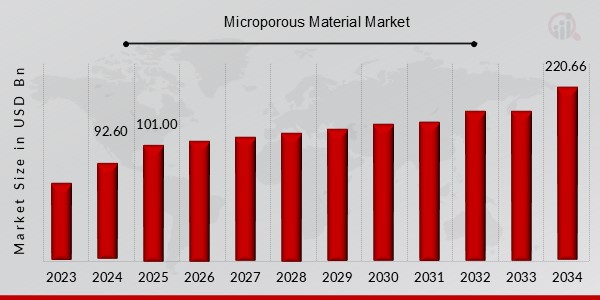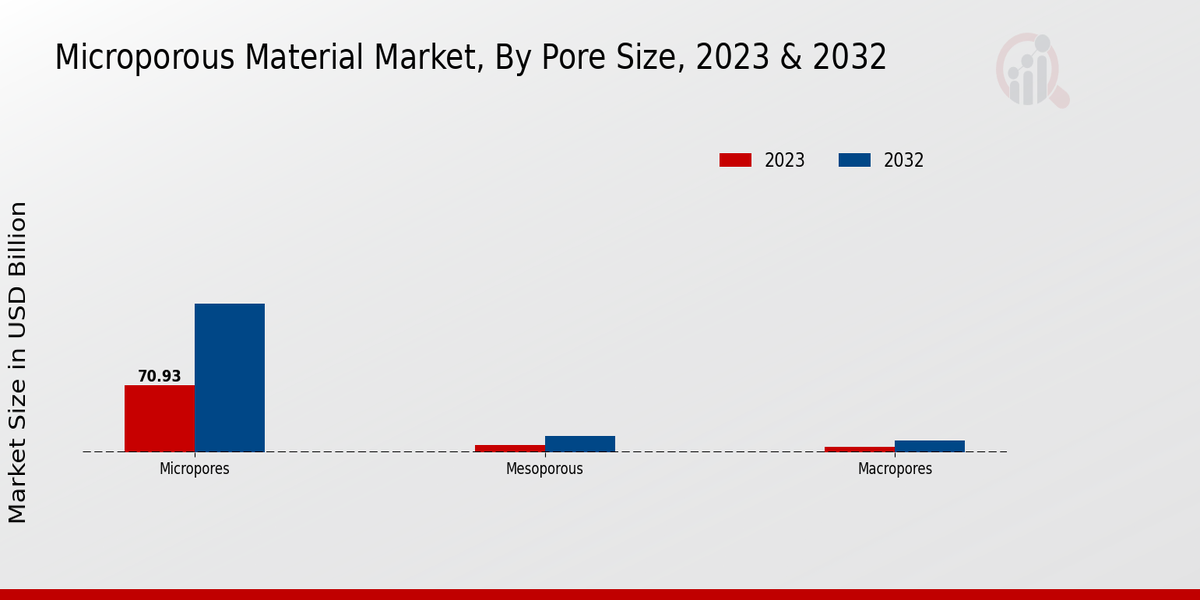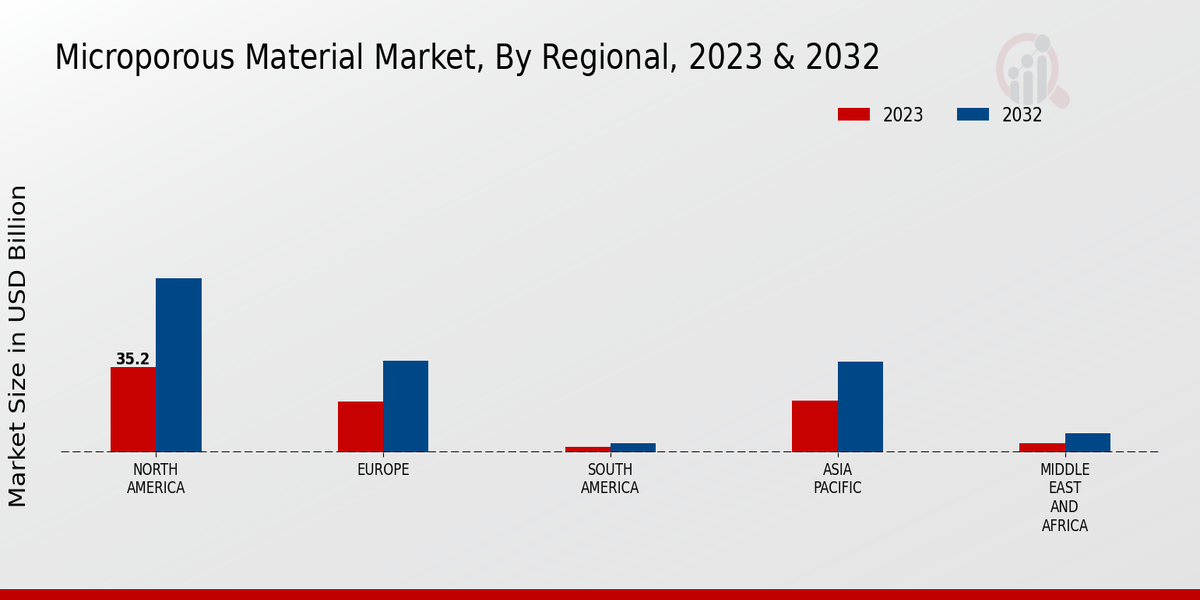Global Microporous Material Market Overview
The Microporous Material Market Size was estimated at 92.60 (USD Billion) in 2024. The Microporous Material Industry is expected to grow from 101.00 (USD Billion) in 2025 to 220.66 (USD Billion) by 2034. The Microporous Material Market CAGR (growth rate) is expected to be around 9.1% during the forecast period (2025 - 2034).
Key Microporous Material Market Trends Highlighted
The microporous material market is witnessing significant growth, driven by the increasing demand for these materials in various industries. Key drivers include their exceptional adsorption and separation properties, making them crucial for applications in gas storage, catalysis, and environmental remediation.
Opportunities abound in exploring novel microporous materials with enhanced functionalities, leading to advancements in areas such as healthcare and energy storage. Recent trends indicate a surge in the adoption of zeolites and metal-organic frameworks (MOFs) due to their tuneable pore size and structure. Additionally, the integration of microporous materials with other technologies, such as nanotechnology and biotechnology, is opening up new avenues for innovation.

Source Primary Research, Secondary Research, MRFR Database and Analyst Review
Microporous Material Market Drivers
Rising Demand for Microporous Materials in Energy Storage and Conversion Applications
The increasing need for efficient and sustainable energy sources is driving the demand for microporous materials in energy storage and conversion applications. Microporous materials, with their high surface area and tunable pore structure, offer exceptional properties for energy storage and conversion, including high energy density, fast charge-discharge rates, and long cycle life. The growing adoption of electric vehicles, coupled with the need for grid-scale energy storage, is expected to fuel the demand for microporous materials in these applications.Furthermore, the development of advanced microporous materials for hydrogen storage and carbon capture and utilization is expected to create significant growth opportunities in the Microporous Material Market Industry.
Advancements in Gas Separation and Purification Technologies
The advancements in gas separation and purification technologies are driving the demand for microporous materials. Microporous materials exhibit exceptional selectivity and adsorption capabilities, making them ideal for gas separation and purification processes. The growing need for clean fuels, petrochemical feedstocks, and medical gases is expected to drive the demand for microporous materials in these applications. Furthermore, the increasing environmental regulations and the need for efficient gas separation and purification processes in various industries, including oil and gas, chemicals, and pharmaceuticals, are expected to contribute to the growth of the Microporous Material Market Industry.
Growing Applications in Catalysis and Adsorption
The growing applications of microporous materials in catalysis and adsorption are expected to drive the growth of the Microporous Material Market Industry. Microporous materials, with their high surface area and tunable pore structure, offer exceptional catalytic activity and adsorption capacity. They are widely used in various catalytic processes, including hydrocarbon cracking, reforming, and polymerization. Additionally, the increasing demand for microporous materials in adsorption applications, such as gas storage, water purification, and pollutant removal, is expected to contribute to the growth of the market.
Microporous Material Market Segment Insights
Microporous Material Market Pore Size Insights
The microporous material market is segmented based on pore size into micropores (2 nm), mesoporous (2-50 nm), and macropores (>50 nm). Among these segments, micropores held the largest market share in 2023 and are expected to maintain their dominance throughout the forecast period. The micropores segment is driven by the increasing demand for microporous materials in various applications such as gas storage, catalysis, and separation processes. The mesoporous segment is projected to witness the highest growth rate during the forecast period.Mesoporous materials have unique properties such as high surface area, tunable pore size, and uniform pore structure, making them ideal for applications in drug delivery, catalysis, and water treatment. The growing demand for mesoporous materials in these applications is expected to drive the growth of the segment. Macropores are characterized by their large pore size and high porosity. They are commonly used in applications such as filtration, chromatography, and as catalyst supports. The macropores segment is expected to experience steady growth during the forecast period, driven by the increasing demand for these materials in various industrial applications.The growth of the microporous material market is attributed to several factors, including the rising demand for these materials in various industries, technological advancements, and increasing government support for research and development activities. The market is expected to witness significant growth in the coming years, with the increasing adoption of microporous materials in various applications across the globe.
Source Primary Research, Secondary Research, MRFR Database and Analyst Review
Microporous Material Market Applications Insights
The Applications segment of the Microporous Material Market has been categorized into Adsorption and Separation, Catalysis, Gas Storage, Energy Storage, and Medical Diagnosis. Among these, Adsorption and Separation held the largest revenue share in 2023, owing to the increasing demand for microporous materials in gas purification, water treatment, and food processing. The Catalysis segment is projected to exhibit a significant growth rate during the forecast period, driven by the rising adoption of microporous materials in catalytic converters and other industrial processes.Gas Storage is another promising segment, with growing demand for microporous materials in hydrogen storage and carbon capture and storage applications. Energy Storage and Medical Diagnosis are emerging segments, offering new opportunities for market growth in the coming years.
Microporous Material Market Base Material Insights
The Microporous Material Market is segmented by base material into Activated Carbon, Zeolites, Metal-Organic Frameworks, Carbon Nanotubes, and Graphene. Among these, Activated Carbon held the largest market share in 2023, accounting for over 40% of the revenue. This is due to its high surface area, porosity, and adsorption capacity. Zeolites are expected to witness the highest CAGR during the forecast period, owing to their unique properties such as high thermal stability, shape selectivity, and catalytic activity. Carbon Nanotubes and Graphene are gaining popularity due to their exceptional mechanical strength, electrical conductivity, and thermal conductivity, making them promising materials for emerging applications in electronics, energy storage, and sensors.
Microporous Material Market Morphology Insights
The morphology segment of the Microporous Material Market is categorized into powders, monoliths, membranes, films, and scaffolds. Among these, powders held the largest market share in 2023, accounting for nearly half of the revenue. The high surface area and versatility of powders make them suitable for various applications, including catalysis, gas separation, and water treatment. Monoliths, characterized by their interconnected porous structure, are expected to witness significant growth due to their enhanced mass transfer capabilities and potential in energy storage and biomedical applications.Membranes, with their selective permeability, find use in filtration, separation, and sensing technologies. Films, known for their thin and flexible nature, are gaining traction in electronics, packaging, and biomedical devices. Scaffolds, with their ability to support cell growth and tissue regeneration, show promise in tissue engineering and regenerative medicine. The market segmentation provides insights into the diverse applications and growth prospects of microporous materials across different morphologies.
Microporous Material Market End-User Industry Insights
The end-user industry segment plays a crucial role in shaping the demand dynamics of the Microporous Material Market. Among the key end-user industries, the chemical and petrochemical sector is projected to account for a significant share of the market in 2023, driven by the increasing demand for microporous materials in refining processes and catalysis. The pharmaceutical industry is also expected to contribute substantially to market growth, fueled by the rising demand for microporous materials in drug delivery systems and biologics manufacturing.Furthermore, the food and beverage industry is anticipated to witness steady growth due to the growing adoption of microporous materials in food packaging and filtration applications. The environmental protection sector is expected to gain traction, driven by the need for efficient wastewater treatment and air purification solutions. Lastly, the energy industry is projected to contribute to market growth, with microporous materials finding applications in fuel cells and energy storage systems.
Microporous Material Market Regional Insights
The Microporous Material Market is segmented into North America, Europe, APAC, South America, and MEA. The North American region is expected to dominate the market with a revenue of around USD 35.2 billion by 2028. The growth in this region can be attributed to the increasing demand for microporous materials in various end-use industries such as construction, automotive, and healthcare. The European region is expected to follow North America with a revenue of around USD 21.0 billion by 2028. The Asia-Pacific region is expected to have the highest growth rate during the forecast period due to the increasing industrialization and urbanization in countries such as China and India.The South American and MEA regions are expected to witness a moderate growth rate during the forecast period.
Source Primary Research, Secondary Research, MRFR Database and Analyst Review
Microporous Material Market Key Players And Competitive Insights
Major players in the Microporous Material Market are focused on expanding their product portfolio and geographical reach. They are also investing in research and development to create innovative products and applications. The Microporous Material Market industry is expected to witness significant growth in the coming years due to the increasing demand from various end-use industries. Leading Microporous Material Market players are adopting various strategies to maintain their market position and gain a competitive edge. These strategies include mergers and acquisitions, joint ventures, and strategic partnerships. The Microporous Material Market development is driven by the growing demand for lightweight and durable materials. Microporous materials are used in various applications, such as filtration, catalysis, and energy storage. The competitive landscape of the Microporous Material Market is expected to remain fragmented, with a number of small and medium-sized players. However, major players are expected to continue to dominate the market.BASF is a leading company in the Microporous Material Market industry. The company offers a wide range of microporous materials, including zeolites, activated carbons, and metal-organic frameworks. BASF has a strong presence and a well-established distribution network. The company is focused on innovation and is continuously developing new products and applications for microporous materials. BASF is expected to continue to be a major player in the Microporous Material Market.UOP, a Honeywell company, is a leading competitor in the Microporous Material Market. The company offers a wide range of microporous materials, including zeolites, activated carbons, and molecular sieves. UOP has a strong presence and a well-established distribution network. The company is focused on providing innovative solutions for its customers and is continuously developing new products and applications for microporous materials. UOP is expected to continue to be a major competitor in the Microporous Material Market.
Key Companies in the Microporous Material Market Include
- Clariant
- Johnson Matthey
- R. Grace Co.
- BASF
- DuPont
- Zeolyst International
- Solvay
- UOP
- Evonik
- Dow
- Honeywell
- Axens
- Albemarle
- 3M
Microporous Material Market Industry Developments
Rising demand for energy-efficient and sustainable materials in various industries, including automotive, construction, and electronics, is driving market growth. Moreover, increasing government regulations and environmental concerns are promoting the adoption of microporous materials as they offer enhanced performance and reduced emissions. Recent advancements in nanotechnology and materials science have led to the development of novel microporous materials with tailored properties, further expanding market opportunities. Key players are focusing on strategic collaborations, acquisitions, and RD investments to strengthen their market position and cater to the evolving needs of end-use industries.
Microporous Material Market Segmentation Insights
Microporous Material Market Pore Size Outlook
- Micropores (2 nm)
- Mesoporous (2-50 nm)
- Macropores (>50 nm)
Microporous Material Market Applications Outlook
- Adsorption and Separation
- Catalysis
- Gas Storage
- Energy Storage
- Medical Diagnosis
Microporous Material Market Base Material Outlook
- Activated Carbon
- Zeolites
- Metal-Organic Frameworks
- Carbon Nanotubes
- Graphene
Microporous Material Market Morphology Outlook
- Powders
- Monoliths
- Membranes
- Films
- Scaffolds
Microporous Material Market End-User Industry Outlook
- Chemical and Petrochemical
- Pharmaceutical
- Food and Beverage
- Environmental Protection
- Energy
Microporous Material Market Regional Outlook
- North America
- Europe
- South America
- Asia Pacific
- Middle East and Africa
| Report Attribute/Metric |
Details |
| Market Size 2024 |
92.60 (USD Billion) |
| Market Size 2025 |
101.00 (USD Billion) |
| Market Size 2034 |
220.66 (USD Billion) |
| Compound Annual Growth Rate (CAGR) |
9.1% (2025 - 2034) |
| Report Coverage |
Revenue Forecast, Competitive Landscape, Growth Factors, and Trends |
| Base Year |
2024 |
| Market Forecast Period |
2025 - 2034 |
| Historical Data |
2020 - 2024 |
| Market Forecast Units |
USD Billion |
| Key Companies Profiled |
Clariant, Johnson Matthey, W. R. Grace Co., BASF, DuPont, Zeolyst International, Solvay, UOP, Evonik, Dow, Honeywell, Axens, Albemarle, 3M |
| Segments Covered |
Pore Size, Applications, Base Material, Morphology, End-User Industry, Regional |
| Key Market Opportunities |
Biomedical Applications Energy Storage Systems Catalysis Processes Gas Separation Technologies Water Purification Technologies |
| Key Market Dynamics |
Growing demand for adsorbents, catalysts, and separation materials Increasing applications in energy storage Environmental regulations driving demand for pollution control Technological advancements and innovation Rising demand from emerging economies |
| Countries Covered |
North America, Europe, APAC, South America, MEA |
Frequently Asked Questions (FAQ) :
The microporous material market is projected to reach approximately USD 92.60 billion in 2024.
The microporous material market is anticipated to reach around USD 220.66 billion by 2034.
The microporous material market is projected to grow at a CAGR of approximately 9.1% during the forecast period from 2025 to 2034.
The Asia-Pacific region is anticipated to dominate the microporous material market in 2024.
The electronics segment is projected to drive the growth of the microporous material market during the forecast period.
Some of the key players in the microporous material market include BASF SE, Merck KGaA, and UOP LLC.
The growing demand for microporous materials in electronics, filtration, and catalysis applications is a major factor driving the growth of the market.
The high cost of production and the stringent environmental regulations are some of the challenges faced by the microporous material market.
The development of new and innovative microporous materials with improved properties presents potential opportunities for the market.
The trend towards miniaturization and the increasing demand for sustainable materials are key trends in the microporous material market.
















